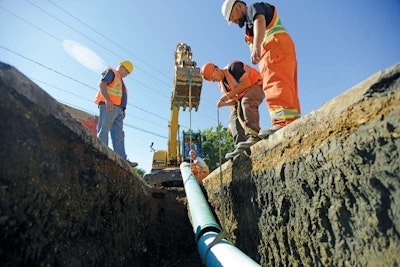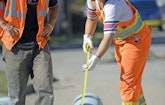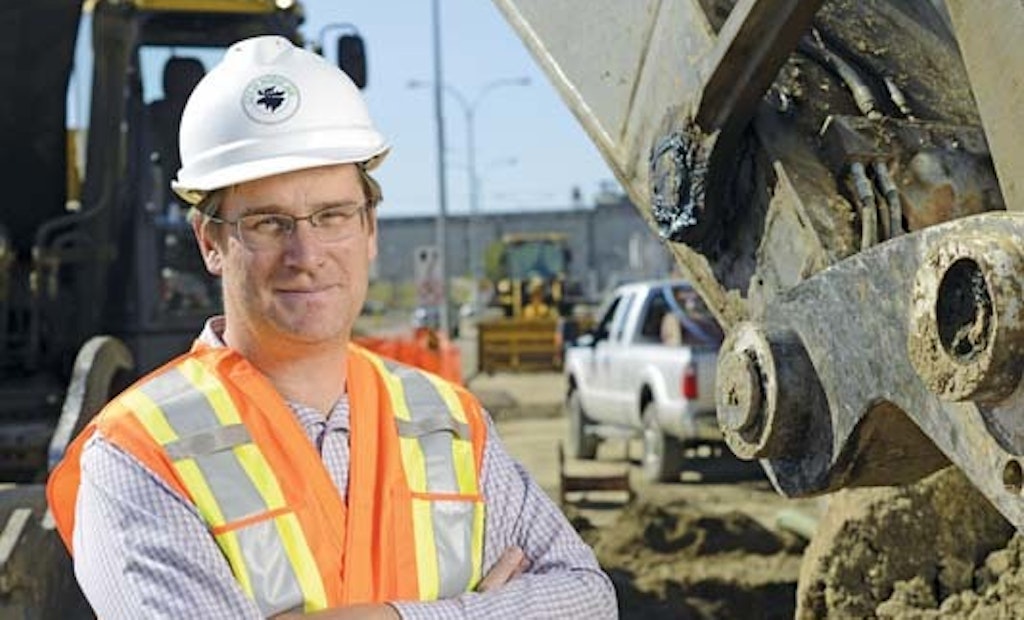Interested in Inspection?
Get Inspection articles, news and videos right in your inbox! Sign up now.
Inspection + Get AlertsThe city of Moose Jaw, Saskatchewan, is focused on infrastructure renewal. For the past three years it’s been prioritizing its infrastructure needs, from roads and sewer systems to its water network. The city started with its hardest sell first — the replacement of 50 miles of cast iron water main nearing the end of its service life at a cost of about $117 million over 20 years.
The city of 33,000 is located about 50 miles west of the provincial capital of Regina and 100 miles north of the Montana border. It’s an important transportation hub, with an economy rooted in industry, resources and agriculture.
Josh Mickleborough, director of engineering with the city, has worked across Canada on everything from sewer projects to asset management system upgrades.
“Having a family brought me to Moose Jaw,” he says. “But the other thing that drew me was a senior management committed to infrastructure renewal. Water is one of the most vital systems supporting the city — as water goes, so does the community.”
The water system dates back to the turn of the 20th century when the city tapped into an artesian well to the east and built 5.5 miles of potable water pipe.
“Over the years, we’ve seen steel, cast iron, asbestos cement and PVC,” says Mickleborough. “Depending on the application, we now prefer PVC or HDPE.”
Pipe diameter ranges from about 3 to 30 inches for transmission mains.
Recent cast iron a problem
“It isn’t the oldest pipe that’s causing us the headaches; it’s the cast iron pipe installed in the 1950s and 1960s that’s the issue for us now,” Mickleborough says. “Whether it was a change in the manufacturing process or quality of the pipe, it’s leading the pack on leaks and breakage. When a city bus got stuck to its axles in the pavement due to a main break, it illustrated the severity of what we were facing.”
Neighboring Regina, which shares the Buffalo Pound Water Treatment Plant with Moose Jaw, replaced its cast iron pipe more than 20 years ago.
City manager Matt Noble arrived in Moose Jaw in 2013 with a mission to upgrade the city’s infrastructure.
“When I came on we were about four years behind in delivering capital programs,” he says. “Previous councils had given us money but we were unable to attract contractors and resources to the community to accomplish them. We were able to change policies and bylaws that gave us the authority to make decisions that would move those programs forward. We also leveled the playing field on our bidding system to encourage a wide variety of contractors, both local and out of town, to offer bids.”
Noble notes that it’s not only sewer and water systems that are on the table. The city is looking at everything from enterprise software to roads, parks and recreation and historical buildings.
“We want to deliver those improvements in an efficient holistic fashion, not on an ad hoc basis,” he says.
Noble says the city was spending $1.7 to $2 million per year on 40 to 50 water main breaks, mostly centered around cast iron pipe. Breaks had become more frequent in recent years, in part because unusually heavy rainfall had saturated the semi-arid soil, driving frost down to the pipes.
Repairs ate up budget
“We were getting anything from leaks to circle breaks to complete blowouts of the entire pipe wall,” Mickleborough says. “Those breaks were also affecting the life expectancy of other infrastructure including roads and sidewalks. It was just throwing money into the ground. Citizens were also complaining about the water quality caused by tuberculation.”
While various pipe rehabilitation methods were considered, the staggering number of failing service connections convinced the city that full replacement was the economical choice.
“Even giving those connections a jiggle might cause them to fail and require digging up the road,” Mickleborough says.
Educating the public
The engineering department also went into education overdrive, holding open houses and explaining the need for the program to citizens. On hand were samples of corroded and tuberculated pipe removed from the system.
City Council gave the green light to the 20-year plan to replace 50 miles of cast iron pipe, concentrating first on the sections demonstrating high break frequency.
“There was acknowledgment from the community that the program had to happen,” Mickle- borough says. “It’s just how you pay for it that generated debate.”
The council-approved funding model for the program has been a hard sell. Under a Local Improvement Project funding model, homeowners whose mains are replaced pick up 30 percent of the cost. Residents can choose to pay a lump sum, or amortize the cost over 20 years.
“Council felt that since the residents get a brand-new street from curb to curb and the resulting increase in property values, these homeowners should contribute something to the project,”
Mickleborough says.
The city is also offering a subsidized rate to completely replace sewer connections made of Orangeburg pipe and entire water service lines, many of which are still made of lead. “As a public health issue, eliminating lead is simply the right thing to do,” Mickleborough says.
During construction, the engineering department will also assess the conditions of sewers in the vicinity of the cast iron mains. (See sidebar.)
While in-house crews perform most of the repairs on sewer and water pipes, the larger construction projects — including the cast iron main project — are being contracted out.
Fleshing out GIS data
“We’re also using this program as part of our efforts to capture accurate GIS information for water infrastructure,” Mickleborough says. “There was a period in recent city history where mapping and recordkeeping was challenged. For example, we don’t have any engineering information on 15 to 20 percent of our service connections. In another case we excavated a 500-foot length of what we thought was cast iron water main and found that it had been replaced 15 years ago.”
The city is using ArcGIS (Esri) to capture GIS data.
Phase 1 of the residential work, which was just completed, encompassed 1 1/2 miles of water main and an additional length of service pipe totaling almost a mile. Water mains were buried as deep as 9 feet to place them below the frost line. The work also included replacement of all valves and hydrants.
The RFP for Phase 2 will go out in January, not only to ensure that contractors have time to sharpen their pencils, but also to ensure work starts early in the summer, maximizing work time before winter.
Meanwhile, the city is applying for federal funding to replace the original 12-mile steel water transmission line extending to the Buffalo Pound Water Treatment Plant. Built in the 1950s, the line is nearing the end of its service life. A project to complete the proper looping of various water mains is also on the table. That work was previously abandoned due to the difficulty of drilling underneath railroads, valleys and streams.
Mickleborough says the city is looking to re-establish a water main flushing program that was suspended around 2010 because it was driving tuberculated water into the system, and also causing main breaks due to increased water pressure. The city is also establishing a valve exercising program, possibly its first. Work on these programs is also helping to drive data about priority areas for cast iron replacement.
“Although it costs money, the cast iron replacement program is probably the best program the city has ever delivered,” Noble says. “We’re enacting programs that will extend the service life of our infrastructure and ultimately make the city more efficient and less expensive to run.”
Building a sewer maintenance program
Water main replacement is front and center for the city of Moose Jaw, Saskatchewan, but the city is also getting its sewer system into shape.
“As part of our infrastructure renewal program we’re currently completing a high-level assessment on the sewer system,” says Josh Mickleborough, the city’s director of engineering. “Right now it’s a mixture of city forces, contractors and consultants that are gathering condition assessment information.”
The sewer pipes are made of everything from clay tile to asbestos cement, concrete, cast iron and even steel — probably recycled from other purposes in the 1920s.
In some cases, sewer pipes were repaired poorly. In others, sections were replaced with undersized pipe, leading to flow restrictions. A cured-in-place pipe lining program is currently targeting the sections most in need of rehabilitation.
The city has owned a RapidView IBAK camera running PipeLogix software for four years. It’s mostly used to inspect blockages. The utility also owns a Vactor 2100 combo unit, but sometimes supplements the equipment by renting a VacHunter trailer vac by PipeHunter.
“Some of the pipes are 30 to 40 percent blocked with anything from sediment and grit to wonderful and surprising things like bags of bullet cases,” Mickleborough says. “We’re currently working to establish a systematic and consistent in-house televising and maintenance program.”
The current lining contractor has given in-house crews some ideas about ramping up the city’s root-cutting capability.
“The crews are requesting a better cutter and some new tools and tips from the equipment reserve budget,” Mickleborough says. “We encourage requests that provide our workers with the tools they need to do the job.”









